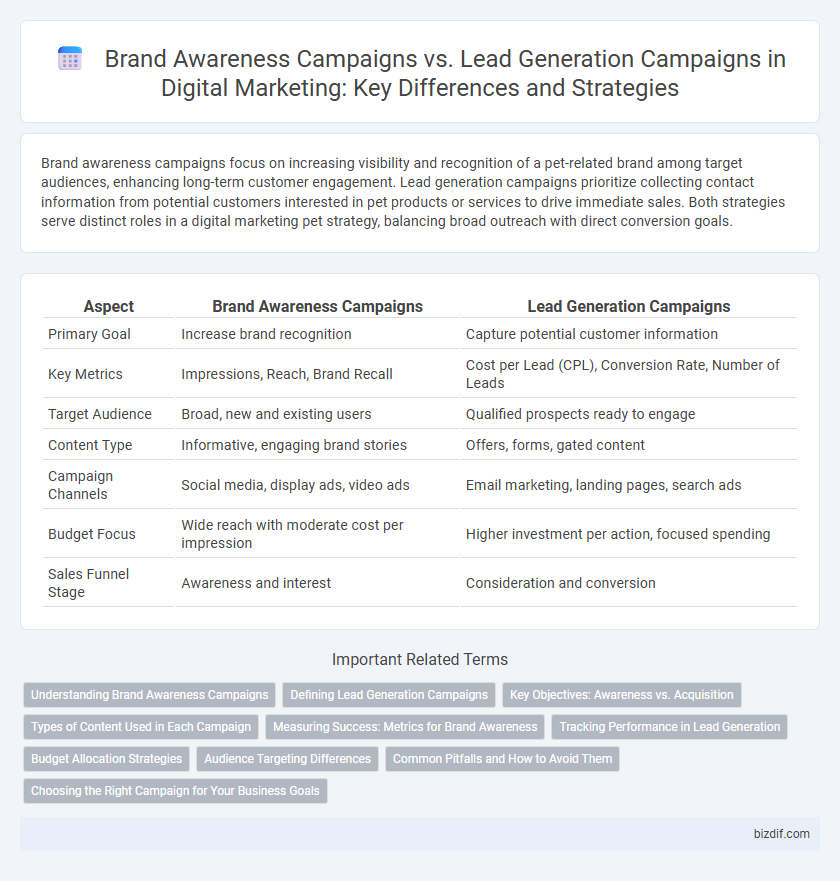Brand awareness campaigns focus on increasing visibility and recognition of a pet-related brand among target audiences, enhancing long-term customer engagement. Lead generation campaigns prioritize collecting contact information from potential customers interested in pet products or services to drive immediate sales. Both strategies serve distinct roles in a digital marketing pet strategy, balancing broad outreach with direct conversion goals.
Table of Comparison
| Aspect | Brand Awareness Campaigns | Lead Generation Campaigns |
|---|---|---|
| Primary Goal | Increase brand recognition | Capture potential customer information |
| Key Metrics | Impressions, Reach, Brand Recall | Cost per Lead (CPL), Conversion Rate, Number of Leads |
| Target Audience | Broad, new and existing users | Qualified prospects ready to engage |
| Content Type | Informative, engaging brand stories | Offers, forms, gated content |
| Campaign Channels | Social media, display ads, video ads | Email marketing, landing pages, search ads |
| Budget Focus | Wide reach with moderate cost per impression | Higher investment per action, focused spending |
| Sales Funnel Stage | Awareness and interest | Consideration and conversion |
Understanding Brand Awareness Campaigns
Brand awareness campaigns aim to increase public recognition and recall of a brand by targeting broad audiences through social media, display ads, and content marketing. These campaigns focus on metrics such as reach, impressions, and engagement rates to measure success rather than immediate conversions. Building strong brand equity through consistent messaging and visual identity creates a foundation for future customer acquisition and loyalty.
Defining Lead Generation Campaigns
Lead generation campaigns are designed to capture potential customers' contact information through targeted offers, such as eBooks, webinars, or free trials, facilitating direct follow-up and sales conversion. These campaigns prioritize high-intent audience targeting and utilize forms, landing pages, and call-to-action buttons to maximize lead capture rates. Measuring success relies on conversion metrics like cost per lead (CPL), lead quality, and return on investment (ROI) to ensure efficient funnel progression from awareness to purchase decision.
Key Objectives: Awareness vs. Acquisition
Brand awareness campaigns prioritize increasing visibility and recognition of a brand among target audiences, aiming to build trust and familiarity over time. Lead generation campaigns focus on acquiring contact information from potential customers to directly nurture and convert them into sales. Emphasizing distinct goals, awareness campaigns invest in broad reach and engagement metrics, while lead generation targets measurable acquisition and conversion rates.
Types of Content Used in Each Campaign
Brand awareness campaigns primarily utilize high-impact visual content such as videos, infographics, and social media stories to engage broad audiences and establish brand identity. Lead generation campaigns focus on targeted content like whitepapers, webinars, and case studies designed to capture user information and drive conversions. Utilizing tailored content formats aligned with campaign objectives maximizes engagement and improves overall marketing ROI.
Measuring Success: Metrics for Brand Awareness
Brand awareness campaigns measure success through metrics such as reach, impressions, and ad recall lift, indicating how many people recognize and remember the brand. Engagement rates on social media posts, website traffic from branded search terms, and sentiment analysis further reveal the effectiveness of brand visibility efforts. These metrics prioritize visibility and audience perception rather than immediate conversion, distinguishing brand awareness from lead generation campaign goals.
Tracking Performance in Lead Generation
Tracking performance in lead generation campaigns relies heavily on metrics such as cost per lead (CPL), conversion rate, and return on ad spend (ROAS) to evaluate campaign effectiveness. Advanced tools like Google Analytics, CRM integrations, and Facebook Pixel enable precise attribution of leads, helping marketers optimize targeting and budget allocation. Accurate tracking empowers businesses to refine audience segmentation and improve lead quality, thereby maximizing the impact of their digital marketing efforts.
Budget Allocation Strategies
Effective budget allocation strategies distinctly impact brand awareness campaigns and lead generation campaigns in digital marketing. Prioritizing higher spend on brand awareness campaigns enhances long-term customer engagement and market presence, while allocating more budget to lead generation campaigns drives immediate conversions and sales growth. Analyzing campaign performance metrics such as Cost Per Thousand Impressions (CPM) for brand awareness and Cost Per Lead (CPL) for lead generation optimizes budget distribution to maximize overall ROI.
Audience Targeting Differences
Brand awareness campaigns prioritize broad audience targeting to maximize reach and familiarize potential customers with the brand identity, often using demographic and interest-based criteria to build recognition. Lead generation campaigns focus on highly specific audience segments, utilizing behavioral data, retargeting strategies, and intent signals to capture qualified prospects ready for conversion. The targeting approach in brand awareness emphasizes visibility across diverse groups, whereas lead generation zeroes in on personalized, high-intent individuals to drive measurable lead acquisition.
Common Pitfalls and How to Avoid Them
Brand awareness campaigns often suffer from vague targeting and unclear messaging, resulting in low engagement; defining a precise audience and crafting consistent, memorable brand messages helps avoid this pitfall. Lead generation campaigns commonly face issues with poor landing page design and weak calls-to-action, which reduce conversion rates; optimizing user experience and employing compelling offers enhance lead capture effectiveness. Balancing budget allocation between reaching broad audiences and nurturing qualified leads ensures a strategic approach that maximizes overall digital marketing ROI.
Choosing the Right Campaign for Your Business Goals
Brand awareness campaigns focus on increasing visibility and recognition by targeting a broad audience to build long-term customer loyalty, making them ideal for new product launches or market entries. Lead generation campaigns prioritize capturing potential customer information through targeted offers and calls-to-action, effectively driving immediate sales and qualified leads. Selecting the right campaign depends on business objectives: use brand awareness to establish market presence and lead generation to accelerate sales growth and customer acquisition.
Brand Awareness Campaigns vs Lead Generation Campaigns Infographic

 bizdif.com
bizdif.com